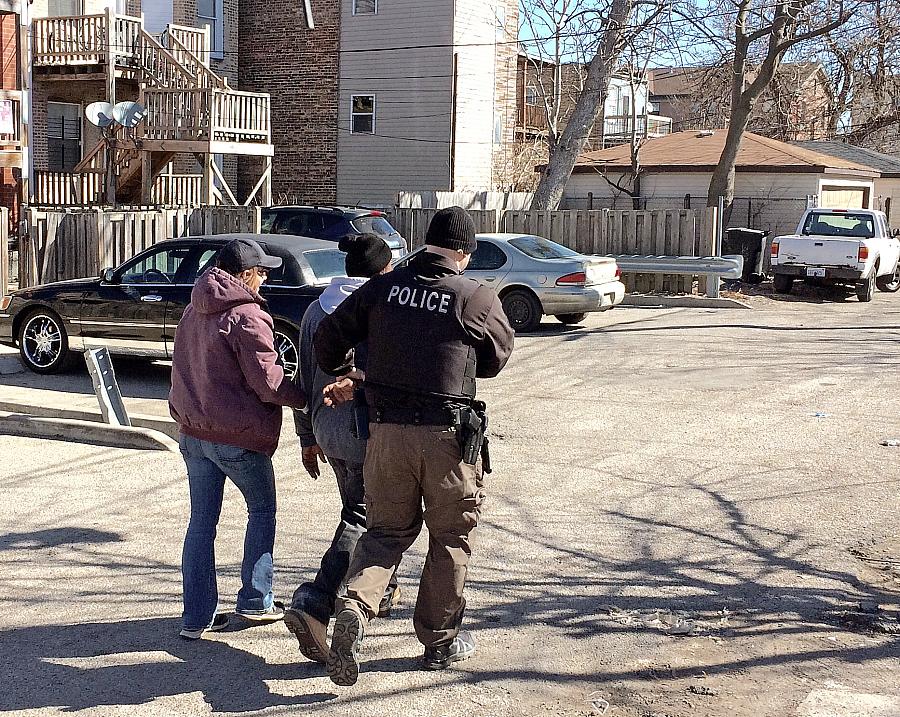Locked up for a ‘dime bag’ in Illinois

Chicago police officers take a heroin buyer into custody on West Flournoy Street in Chicago.
(Photo by Frank Main/Chicago Sun-Times)
Raymond Galloway was chatting with a woman on the street on Chicago’s West Side in late April when he saw a police officer, turned and walked away with his hand in his right jacket pocket.
According to police, this was evidence of an “interrupted narcotics transaction.” They stopped him, found 0.2 grams of heroin in his jacket — a small amount called a “dime bag” on the street — and charged him with felony drug possession.
“It was dust, man,” Galloway said. “I was, like, ‘Y’all taking me to jail for this?’”
It was a case that prosecutors would drop weeks later due to the small quantity of drugs.
But by then, the damage had been done to the 47-year-old line cook who, at the time of the arrest, was out on bail from an earlier drug charge. Before prosecutors dropped the charges, Galloway had spent two weeks in jail followed by confinement at a halfway house — an ordeal he said kept him out of work and away from his family for nearly a month.
“It impacts my life,” Galloway said. “I can’t pay the phone bill. I’m two months behind on my rent. Child support, I got kids to take care of. I can’t do anything. When I do have to go to court, I have to ask and borrow money just to get to court because, the place I’m at, they don’t provide us with bus passes.”
Galloway’s story is one that plays out in Cook County courthouses almost every day.
Since 2000, hundreds of thousands of people charged with felony possession of controlled substances have passed through the Cook County circuit court, one of the largest unified court systems in the nation.
More often than not, cases involving small amounts of narcotics are dismissed within the month, though not before consuming an enormous amount of government resources and wreaking havoc on the lives of the accused and their families.

This is a byproduct of an Illinois law that makes possession of any non-prescription narcotic — as little as a single pill of Xanax or a grain of heroin — a felony.
The Better Government Association and the Chicago Sun-Times are examining these drug cases by using criminal data from the Cook County Clerk of Circuit Court. The data was obtained through a Chicago journalism collaborative called The Circuit. The collaborative created its own database by scraping data from the court system and organizing it. It includes every event for every criminal case filed in Cook County for nearly two decades, which allows for a first-of-its-kind analysis of the criminal justice system in Chicago.
According to the court data, the median age of the drug-possession defendants is 46, and 9% are 60 or older. Most are poor and male. And as many as 62% of them are Black, though Cook County’s Black population is 23%.
While possession arrests occur citywide, they are heavily concentrated on the West Side. Over decades, white flight and disinvestment have transformed many city neighborhoods from blue collar strongholds to segregated slum areas.
Situated near the expressway that connects Chicago to its west suburbs, city neighborhoods such as Austin, North Lawndale and West Garfield Park are known for their open-air drug markets. The operations are often gang-run and have flourished despite the possession arrests, federal prosecutions and other law enforcement tactics meant to stem the drug trade and the staggering gun violence linked to it.
On any given day, walk down Pulaski Road south of Madison Street, an intersection that was a signature commercial hub in the early 20th century, and you see the markets in full swing: the handshake sidewalk exchanges, dealers advertising their wares, the conveyor belt of drug users in various states of withdrawal.
“Now, the open-air drug markets are allowed to thrive on the West Side because there’s nothing else there,” Cook County State’s Attorney Kim Foxx said. “And we treat it almost like this stale talking point of what disinvestment looks like. But you literally have large swaths of property that have been abandoned, and drug sales are just out there. And it does take down property values. People aren’t willing to come invest in those neighborhoods. People are afraid to even put in grocery stores over there because you have so many people with these issues. If you are only looking at law enforcement to solve this and doing nothing about the demand, this is what we get.”
Our series for the 2021 National Fellowship will spotlight the drug laws in Illinois and their impact. It will focus on several areas: Chicago police tactics and drug laws; the courts in which these cases are adjudicated; the millions of dollars in taxpayer money spent annually on incarceration in county jails and state prisons; and the lives of the drug users. Our reporting will explore the financial impact drug charges have on them; the health care and transportation disparities that complicate treatment; the law’s inability to cope with the fatal overdoses that have spiked in the COVID-19 era; and the Chicago drug economy that’s becoming more suburban as the painkiller epidemic alters patterns of heroin use.
We’ll also explore alternatives, such as a new law in Oregon, passed through a ballot measure, that makes possession of small amounts of drugs a ticketable offense and diverts millions of dollars in tax revenues from the sale of recreational marjuana into drug treatment facilities.
It’s an honor to be awarded the 2021 National Fellowship. We look forward to working with other fellows and mentors as we complete this project.


